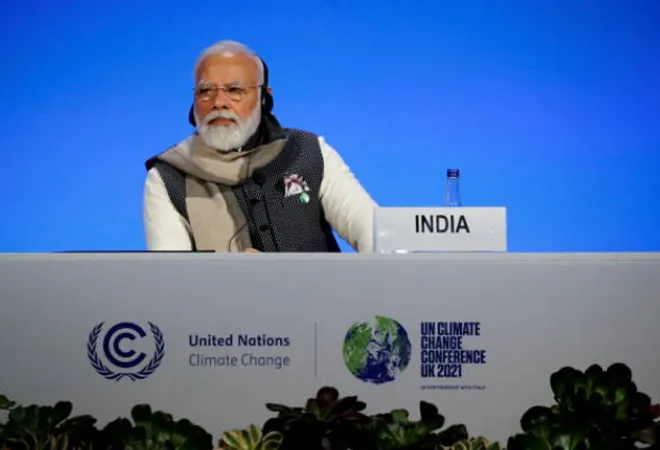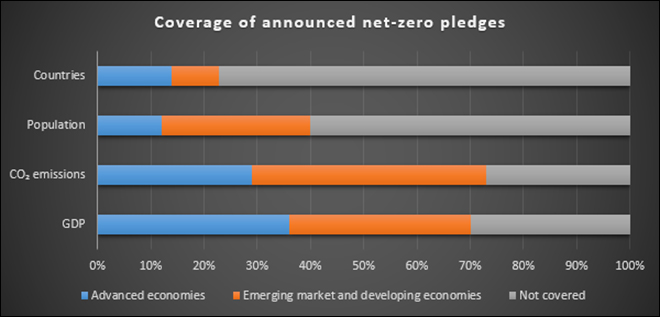
This article is part of the series Comprehensive Energy Monitor : India and the World
A joint statement issued by Quad (Quadrilateral Security Dialogue) countries in September 2021, stated that all member states intend to update or communicate ambitious nationally determined contributions (NDCs) under the Paris Agreement before the 26th Conference of Parties, or COP26. But statements by the concerned ministers from the Indian government that followed this news reiterated historical responsibility of the western nations over climate change and repeated the issue of inadequate financial assistance from rich countries leading most observers to believe that India is not likely to make any significant change from its traditional position. The day before the speech of the Indian Prime Minister (PM) at COP26, there was news that India is likely to link any new pledges on decarbonising India’s economy to its membership in the nuclear suppliers’ group (NSG). The argument that linked NSG membership to climate action was that nuclear power, a low carbon alternative energy source could potentially replace coal as baseload power and that India would need to be a member of the exclusive NSG group to access nuclear fuel, capital, and technology. But news on the English language Chinese media did not offer any hope on NSG membership. In the end, the Indian PM surprised observers within and outside India with the following ambitious and what at this point appear to be unconditional pledges on India’s decarbonisation during his speech at COP26:
- Increase non-fossil energy capacity to 500 GW (gigawatts) by 2030.
- Meet 50 percent of energy requirements from renewable energy (RE) by 2030.
- Reduce the total projected carbon emissions by 1 billion tonnes (BT) by 2030.
- Reduce the carbon intensity of the economy by less than 45 percent.
- Achieve net zero carbon by 2070.
Many environmentalists hailed these five pledges (“Panchamrit”) as it is expected to put India on a firm path towards decarbonisation. For commercial entities betting on green investments to pay-off handsomely, the announcements offer the comfort of certainty that government policy will protect their returns. The validity of these expectations will only be revealed in the long term but the immediate concern from a more objective point of view is the interpretation of the somewhat ambiguous pledges. The assumption at this point is that these are aspirational, non-binding pledges and the official statement on the revised NDCs will clarify some questions that the pledges raise.
The day before the speech of the Indian Prime Minister (PM) at COP26, there was news that India is likely to link any new pledges on decarbonising India’s economy to its membership in the nuclear suppliers’ group (NSG).
Ambiguities
- Increase non-fossil energy (electricity?) capacity to 500 GW (gigawatts) by 2030: The term energy is used in the translation of the PM’s speech, but it is very likely that the reference was made to electricity. This pledge is probably linked to the existing pledge to increase RE installed capacity for power generation to 450 GW by 2030. If so, India has pledged to more than triple current non-fossil fuel capacity of about 154 GW to 500 GW in the next 9 years.
- Meet 50 percent of energy (electrical?) requirements from renewable energy (RE) by 2030: This pledge is difficult to interpret but again if the reference is to electricity rather than primary energy, then India must increase the consumption of RE (currently about 10 percent of power generation) by five times in the next nine years to meet this goal. If the reference is to primary energy, then the challenge is almost unachievable because the current share of RE in primary energy consumption is less than 2 percent.
- Reduce the total projected carbon emissions (in the business-as-usual scenario for 2030?) by 1 BT by 2030: This is a radical pledge as it promises an absolute reduction in carbon dioxide (CO2) emissions by 2030. CO2 emission from India is expected to increase from about 3 BT to about 2.9 BT by 2030 under current policies. If India were to reduce this by 1 BT, India will effectively return to CO2 emissions in 2007. This would mean a reduction in overall energy consumption or a spectacular increase in consumption of RE. What this would mean to the economy is best left to imagination.
- Reduce the carbon intensity of the economy by less (at least?) than 45 percent (compared to carbon intensity in 2005?): This is probably the least ambiguous of the five pledges made. One of India’s ongoing NDC commitment is to reduce India’s CO2 intensity by 33-35 percent from 2005 levels by 2030. According to government statements, India’s CO2 intensity has fallen by 28 percent compared to 2005 levels in 2020. If the drivers behind India’s reduction in CO2 emissions in the last three decades such as the shift towards less energy intensive service sector, shift in household cooking fuel from inefficient biomass to efficient petroleum and natural gas-based fuels, increase in industrial energy efficiency continue, India can achieve this goal. However, if India’s current industrial policy that is oriented towards increasing domestic manufacturing succeeds, meeting this goal will also become somewhat difficult. Manufacturing is energy intensive and consequently also carbon intensive.
- Achieve net zero carbon by 2070: This is probably the only pledge that was expected from India at COP26 because many top CO2 emitters, especially China and the USA the largest and second largest emitter of CO2 have made net zero pledges (China by 2060 and USA by 2050).
The idea of “net zero” was promoted in a 2018 special report from the Intergovernmental Panel on Climate Change (IPCC) which demanded that countries bring greenhouse gas emissions to “net-zero” by 2050 to keep global warming to within 1.5 °C of pre-industrial levels. Though net-zero was the universal language for policymakers’ intent on sealing a deal at COP26, net zero is also seen as the means to perpetuate a belief in technological salvation to diminish the sense of urgency over climate calamity. As the concept of “net zero” has built-in ambiguities, it was the safest promise a country or company could make.
Issues
India committing to “net-zero” at COP26 was unavoidable from a geo-political perspective but the offer of far more radical pledges with no “quid pro quo” is puzzling. The quick answer is probably that it is in India’s interest to protect itself against the impact of climate change by limiting carbon emissions deeply and quickly. But climate change is a global commons problem and unless all large polluting nations reciprocate with radical pledges to limit carbon emissions, the climate will change for the worse. Ideally, India’s pledges should have been hedged with the condition that other large polluters achieve net zero before 2050 and make the necessary funds available to India.
If India’s current industrial policy that is oriented towards increasing domestic manufacturing succeeds, meeting this goal will also become somewhat difficult. Manufacturing is energy intensive and consequently also carbon intensive.
But there is another contradiction that adds to the ambiguity. India was not part of the non-binding agreement signed to phase out coal by 2030 for rich countries and 2040 for poor countries at COP26. Other large coal using nations including China, USA and Australia were also not part of the signatories. Britain, the host of COP26 wants to consign coal to history based on its own history. But Britain switched from coal to gas in the 1980s partly to spite coal unions and partly to embrace cheap new offshore natural gas. A complete switch from coal to natural gas will pose serious economic challenges to India as imported natural gas is the most expensive fuel (for power generation) at the margin. Imported gas will also mean geo-political and external trade related risks to India’s energy security.
Coal is narrowly seen as the main adjustment variable between the ‘business as usual’ and the ‘low carbon’ energy paths for India. But millions of people awaiting better quality of life through large scale industrialisation that offers well paid and secure jobs are the main adjustment variable between the two paths. If large scale industrialisation takes off in India, quality of life will improve for millions of households, but it will add to the volume of carbon content in India’s energy basket barring a miracle in clean energy technologies. India’s COP26 pledges are ambitious and ambiguous, and hopefully also aspirational (non-binding), in which case one could say there is nothing wrong in aiming high.
 Source: International Energy Agency, 2021, Net Zero by 2050, IEA, Paris; Note: The chart does not include India’s pledge to net zero
Source: International Energy Agency, 2021, Net Zero by 2050, IEA, Paris; Note: The chart does not include India’s pledge to net zero
The views expressed above belong to the author(s). ORF research and analyses now available on Telegram! Click here to access our curated content — blogs, longforms and interviews.





 PREV
PREV




